What comes to your mind when you hear the name Florida? If you’re familiar with the state, then I’m sure you’ll immediately think of white sands, Blue Ocean, and tropical palm trees, which are one of the most identifying features of the Florida skyline.
There are several types of palm trees in Florida, which grow throughout the state. The state has a warm tropical climate, making it one of the most ideal places in the world to grow palm trees.
Florida has many tall and majestic palm trees and they usually grow along the roads, near beaches, and in parks. You will also find some dwarf and small palm trees in Florida, which can make fantastic residential garden landscapes.
Today, we will be looking at the different types of palm trees native to Florida, types of small palm trees in Florida, glowing zones in Florida, and we will also answer some frequently asked questions about Florida palm trees.
Let’s get started!
Table of Contents
Florida Growing Zones
Florida growing zones is divided into USDA zones 8 to 10, and zone 11 is the Florida Keys.
In Florida, the northern parts are in zone 8a – and their temperatures can reduce to 15°F (-9°C) in winter. So, it’s important to only grow cold-hardy Florida palm trees in this part of the state.
On the other hand, Miami falls under zone 10, with minimum temperatures from 30°F (-1°C) to 40°F (4°C). Palm trees typically need to endure short attacks of cold temperatures but flourish well in warm summers.
Are Palm Trees Native to Florida?
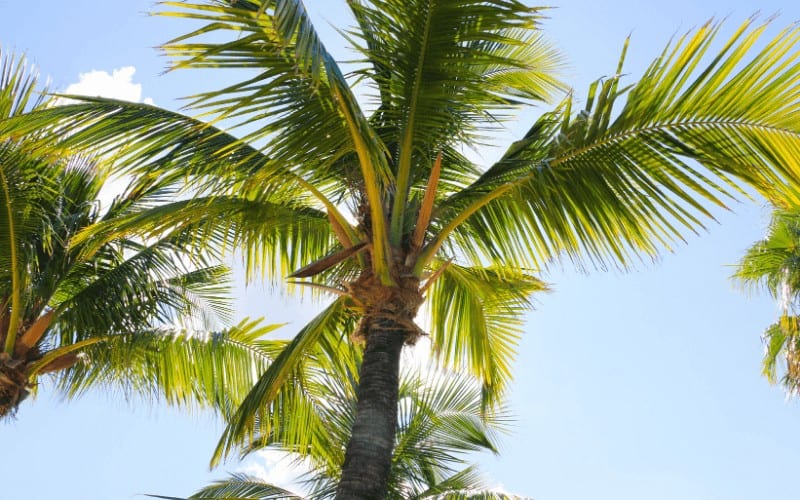
While Florida is an excellent environment to grow palms, only a few palm trees are native to Florida. According to Florida ecologists, “only about 12 species of palm tree are native to the state.”
Every other species of palm seen in the state came from either Southeast Asia or South America. Today, they all form an attractive whole, making Florida a palm tree state.
Facts About Florida Palms | Native Florida Palm Trees
A few of the most common native Florida palm trees include:
- Needle palms
- Cabbage palms
- Silver palms
- Royal palms
- Etc.
Palms are members of the Arecaceae family and you can always identify them via their thick, long stems and crown of arching branches.
Some of the tallest palms in Florida can grow up to 100 ft. (30 m) tall, while the shortest or dwarf native Florida palm trees can be as small as 20 ft. (6 m) tall.
Different Types of Palm Trees in Florida
Now, let’s look at some of the common types of palm trees in Florida. Here, we will talk about both the native Florida palm trees and the one that were imported from other countries.
1. Sylvester Palm (Phoenix sylvestris)
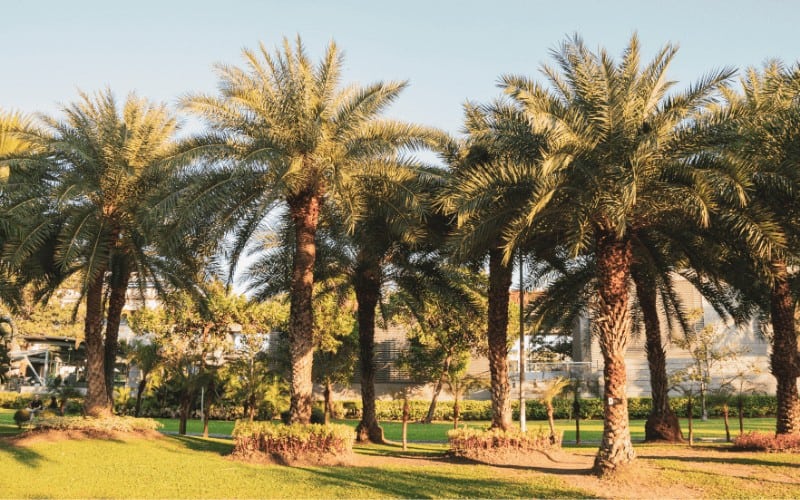
Also known as “silver date palm,” the Sylvester palm is a popular plant in Florida that is often used in landscapes, even though it’s not native to Florida. The Phoenix sylvestris is a medium-sized palm tree with a fat trunk that looks more like a pineapple’s skin.
This drought-tolerant, cold-hardy, and slow-growing palm tree grows to about 13 ft. to 50 ft. (4 – 15 m) tall with a 32 ft. (10 m) broad leafy crown.
You can easily identify Sylvester palm tree by their sharp, stiff, pointed fronds, a vast bushy palm crown, and a rough fibrous trunk. You will find Sylvester palms in all parts of Florida – and it’s hardy in zones 8b through 11.
2. Foxtail Palm (Wodyetia bifurcate)
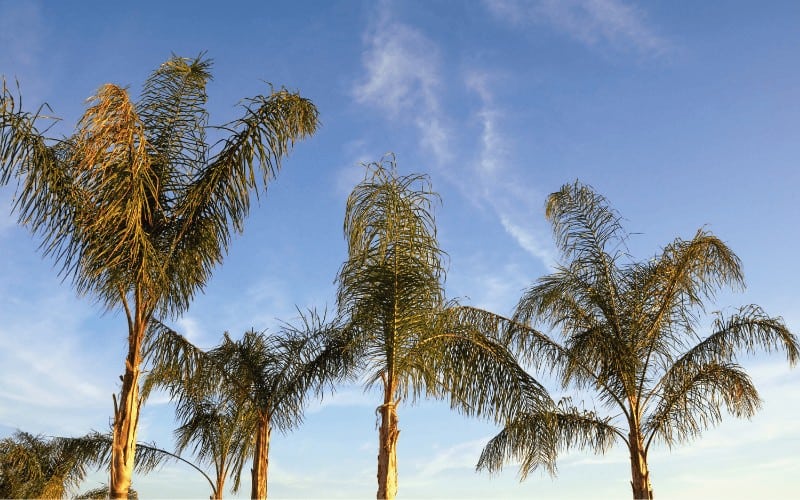
Foxtail Palm is another medium height palm tree that is also popular in Florida. It has a smooth self-cleaning trunk with a green crown shaft and a crown of feathery leaves that resembles a tail of the fox.
This palm grows at a medium rate and can reach up to 25 – 30 feet tall and is often used for small landscapes. It thrives in full sun and tolerates hot temperatures of 100F.
It can also survive cold temperatures down to 30F. Foxtail palms can be grown in a container on a patio; however, it doesn’t make a good indoor plant as they don’t like the shade.
3. Bismarck Palm Tree (Bismarckia Nobilis)
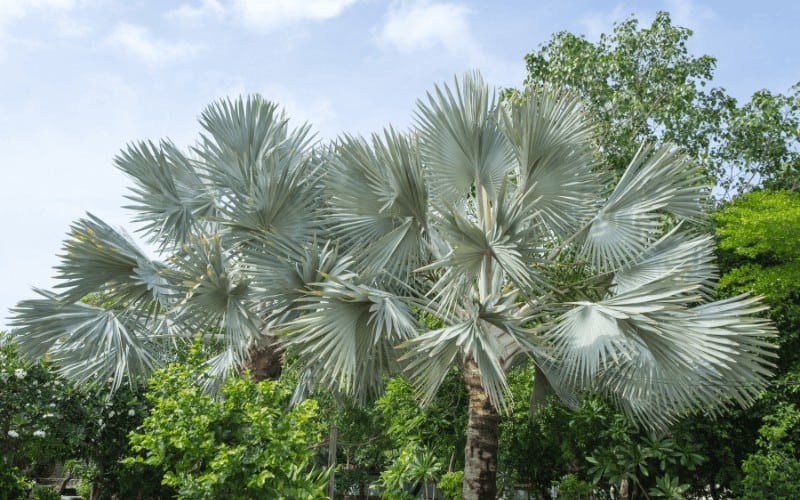
Native to Madagascar, Bismarck palm tree is an exotic, monotypic type of flowering palms that was named after Otto von Bismarck, who was the first chancellor of the German Empire. “Nobilis” is a Latin word that means “noble.”
Bismarckia Nobilis can be found in South Florida, where the soil well-drained and is relatively wet – and it can grow up to 40 ft. (12 m) tall, about 10 to 16 ft. (3 – 4.9 m) wide. It produces a thick trunk that grows up to about 18 inches (46 cm) in diameter.
It also has beautiful silvery-green palmate fronds that are usually up to 4 ft. (1.2 m) long. The Bismarck palm is a slow growing palm; hence, it requires less frequent pruning.
It prefers warm climates and thrives in the sunniest areas; however, it can also grow in temperatures of 15 F (-9.5 C) once established.
4. Chinese Fan Palm (Livistona Chinensis)

Chinese fan palm is a subtropical palm tree that is native to China, Taiwan, and Japan, but eventually naturalized in Florida. The palm is classified as an invasive species of palm in some parts of Florida.
Excitingly, if you don’t have enough space in your garden, this Florida palm tree can also be grown indoors as a potted houseplant, which is why it is loved by many.
The name “Chinese Fan Palm” came from its fan-shaped fronds drooping down like a fountain from its crown. It is a slow-growing, hardy palm tree that grows up to 30 to 50 feet (9 – 15 m) tall and can reach up to 12 feet (3.7 m) wide.
It produces a bluish-green, or deep-green, 6 ft (1.8 m) long fronds that grow in circular, segmented fans when the palm is young. They also grow spines in their early stage but lose them as time goes on.
5. Dwarf Palmetto (Sabal minor)
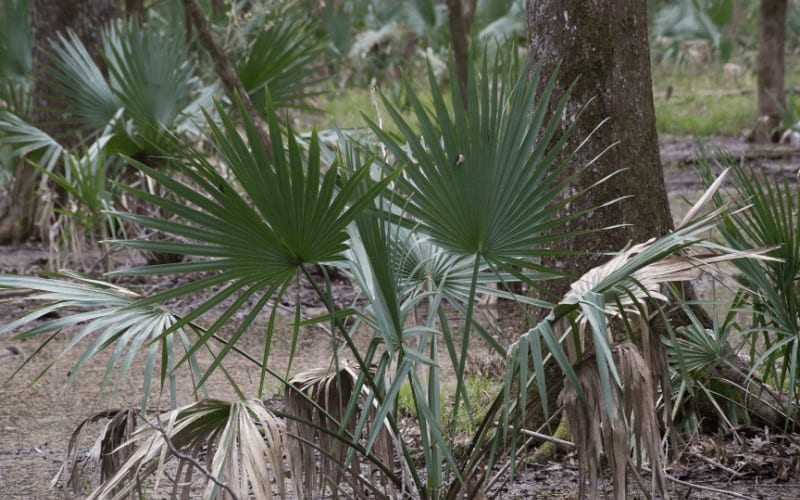
Dwarf palmetto palm tree develops large fan-shaped fronds, smooth branches, and a short fat trunk. As its name suggests, this is one of the smallest types of palm trees in Florida, and it usually does not grow more than 3 ft. (1 m) tall.
The dwarf palmetto is a cold-hardy Florida palm and can thrive in temperatures as low as 0°F (-18°C). This small Florida palm tree can be used for residential garden landscapes and is hardy to zones 7 to 10.
In terms of Florida palm tree identification, the dwarf palmetto can be easily identified by its green fronds growing on a short, smooth trunk and has the shape of a fan.
6. Saw Palmetto (Serenoa repens)
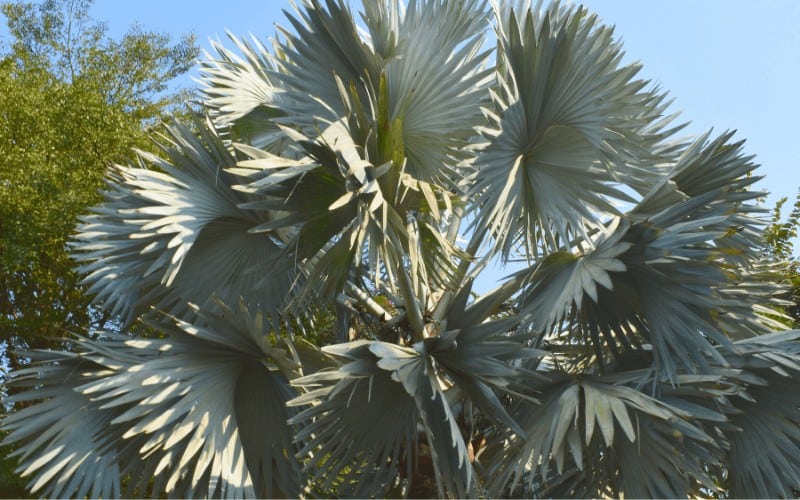
Saw palmetto is a moderately cold-hardy Florida palm that can be found throughout the state and grows up to about 7 and 10 ft. (2 – 3 m) tall. It produces palm fruit that comprises of big dark red drupes.
In Florida, you can identify the saw palmetto palms via its fan-like fronds, yellowish-white flowers, and sharp spiky branches.
As for Florida palm tree identification, the saw palmetto palm tree can be identified by its crooked stem, sharp branches, and large leaves that resembles a fan. This palm tree is cold hardy to 20°F (6°C) in zones 9a to 11.
7. Needle Palm (Rahpidophyllum hystrix)

Native to Florida, the needle palm is one of the hardiest palm trees in the State. It is hardy to 5°F (-15°C) – and grows well in zones 6 through 10.
The needle palm is relatively short or mini bushy palm tree. The tree can be identified by its thick trunk and leaves growing in a fan-like shape and creating a rounded crown on the palm.
It’s a small hardy Florida palm tree and reaches a height of about 3 – 4 ft. (1 – 1.2 m). The short palm can also be identified by its stout trunk, clumping growth of leaves that has the shape of a fan, and rounded growth.
If you’re looking for a small palm tree that is native to Florida, the needle palm is one of them.
8. Mexican Palm Tree (Washingtonia Robusta)

Native to northwestern Mexico, the Mexican palm tree is a fast-growing palm that naturalized in Hawaii and Florida. It is a cold-hardy, salt-tolerant palm tree that can be successfully grown in a coastal area.
The palm tree grows a narrow, 80 – 100 feet (24 – 30.5 m) tall reddish-brown trunk that is only about 2 ft (61 cm) in diameter, which makes it vulnerable to hurricane as it can easily break.
The tree also grows fan-shaped bright-green leaves on its top thrive crowns with 3.3 to 5 ft (1 – 1.5 m) long, with leafstalks that has a beautiful red stripe on the underside.
This palm also produces lovely small white flowers that are placed on a yellow stem with edible blue-black, round fruit.
9. Latania Palm (Latania lontaroides)
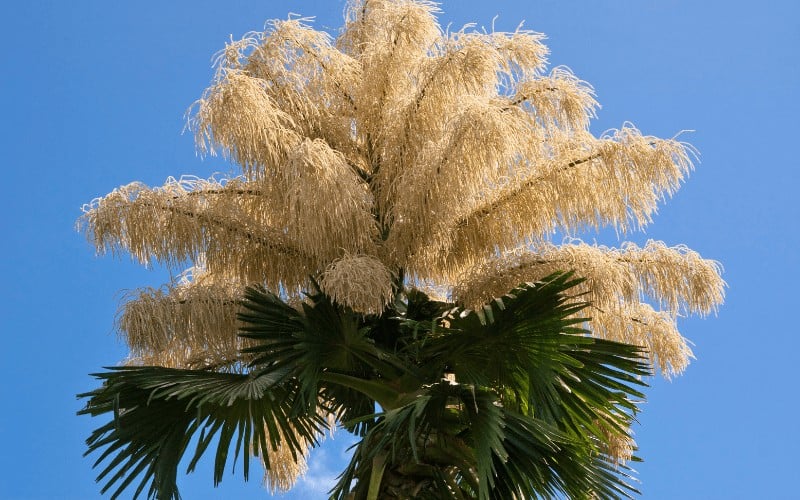
The Latania Palm tree is a very attractive species of palm that easily grabs attention. This palm is salt-tolerant and is ideal for Central Florida as it prefers the sun and sandy soil.
Due to their hardiness in tropical climates, Latania palm is a viable palm tree for temperate gardens.
10. Royal Palm (Roystonea oleracea)

Royal Palm is another beautiful, fast-growing palm that is native to Florida and Sought America.
It has a gray trunk that is self-cleaning with extended smooth crown shaft from where the feathery leaves came out from. Royal palms can grow up to 60 feet tall but is often shorter if grown in a pot.
Aside from its amazing looks, this palm can tolerate both hot and cold conditions, which is why most growers love it. It can typically survive in cold down to 30F; however, it’s worth noting that some plants in Southern California have survived cold under 25F.
This palm is fantastic for landscapes, regardless of where it’s planted. You can also use it to line a property, a street, or a driveway – and it’s ideal for each side of the entry, as a stand-alone or as an architectural accent.
11. Scrub Palmetto (Sabal etonia)

Scrub palmetto is a short palm tree that is only native to Florida and can be easily identified by its fan fronds growing on top of a solitary thin stem.
While the trunk can reach up to 6.6 feet (2 m) tall, it is usually below ground. The Florida scrub palmetto palm produces serrated frond palm leaves that can be used for ground cover.
The best way to identify the scrub palmetto is through its thin yellowish-green blades that grows in a fan-like shape with a slightly curved growth.
Finally, scrub palmetto is a cold-hardy palm and grows in USDA zones 8a through 11. Good enough, this palm can thrive in temperatures as low as 10°F (-12°C).
12. Florida Thatch Palm (Thrinax radiata)
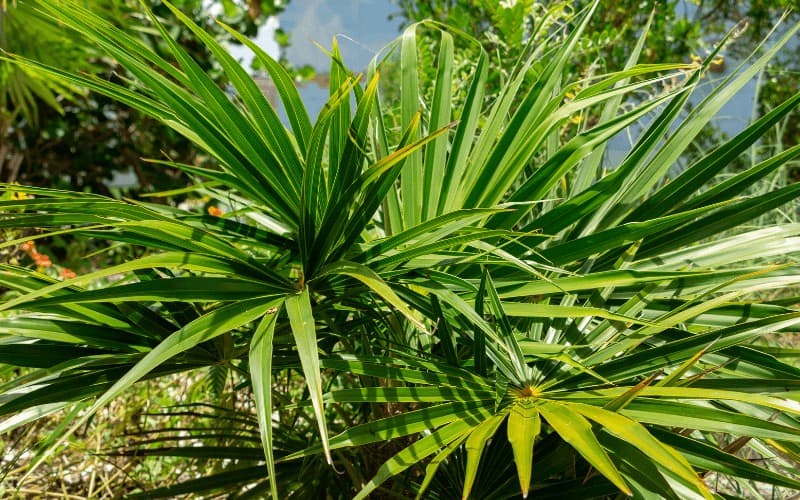
Florida thatch palm tree is among the species of skinny palms with between 10 – 20 green palmate fronds forming a canopy.
It’s a cold-sensitive palm tree and thrives best in coastal regions, and makes for an impressive plant in garden landscapes – but can be grown in containers too. The Florida thatch palm tree grows a single slim trunk with a crown of palmate leaves.
This palm also grows slowly and can grow up to a height of 20 feet (6 m). Its ideal for growing in south Florida as it grows in USDA zones 10 to 11.
13. Florida Silver Palm (Coccothrinax argentata)
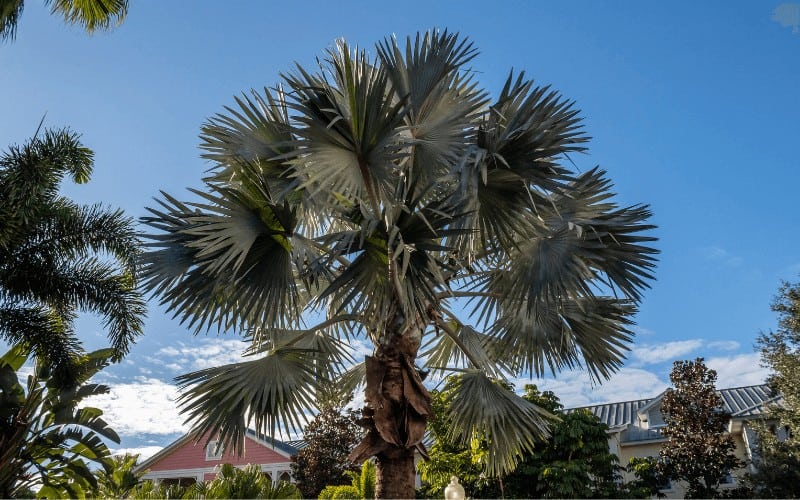
Florida silver palm is a type of small palm tree that is native to Florida, and is often grown in the southern part of Florida in zones 10b to 11.
The palm can be identified by its slim, smooth trunk, globose purple palm fruits, as well as dark blue-green fronds with a silver underside. It grows between 6.5 and 20 feet (2 – 6 m) tall.
When you’re trying to identify this small Florida native palm, you will also want to look for palmate compound silvery-gray fronds that gives the tree crown a globular look.
FAQs About Florida Palm Trees
How do I identify a palm tree in Florida?
You can usually identify a palm tree species in Florida (and any other part of the world) by the distinctive shape of its palm fronds (leaves)., Palm tree leaves are typically either palmate (fan-like leaves), or pinnate (feather-like fronds).
That said, you can also identify a palm tree by its trunk shape.
How many types of palm trees are in Florida?
There are generally more than 2,600 species of palms tress in the world, but only about 12 species of palm tree are native to Florida.
However, almost all palm tree species can be grown in the state.
What city in Florida has the most palm trees?
Naples has the most palm trees in Florida.
According to Naples News, Naples has about 15,000 palm trees. In fact, the city has far more palms than other types of trees.
What is the fastest growing palm tree in Florida?
The fastest growing palm tree in Florida is the Carpentaria Palm (Carpentaria acuminata), which is popular in South Florida.
Do palm trees naturally grow in Florida?
Yes, palm tree grows in Florida naturally. In fact, Florida has about 12 palm tree species that are native to the state.
Can date palms grow in Florida?
Dates palms grows in Florida during the rainy season; however, they generally get moldy and die off before they can mature. Date palm survives in temperatures above 20 degrees Fahrenheit (-6 C.).
In the United States, most date palm production is in Arizona and southern California.
Related Posts:
- How To Save a Dying Potted Palm Tree
- How To Deal With White Fungus on Palm Trees
- How To Prevent Palm Trees From Growing Taller
- How to Trim Palm Tree Trunk
- Should Seed Pods Be Removed From Palm Trees?
Conclusion | Types Of Small Palm Trees In Florida
As you can see, there are dozens of different types of palm trees in Florida. The state is well-known for its beautiful palm trees.
Therefore, if you leave in Florida and you’ve been wondering what species of palm trees thrives in the state the most, we hope this article has provided you with all the information you need to choose the right palm for your needs.




